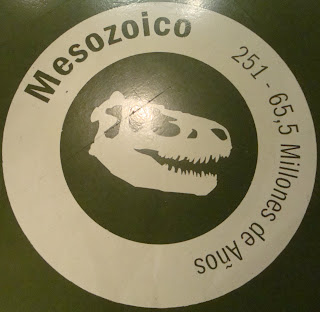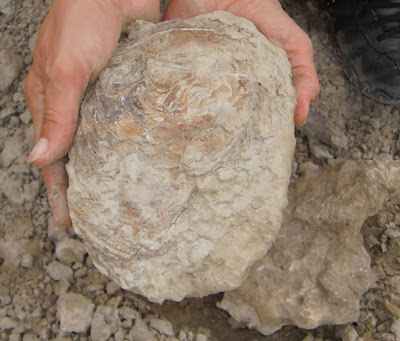A Coral reef is a ridge or mound of limestone, the upper surface of which lies, or lay at the time of its formation, near the level of the sea, and is predominantly composed of calcium carbonate secreted by organisms, of which the most important are corals. (Vaughan,T.W., Physical conditions under which Paleozoic coral reefs were formed )
A beautiful fossilized coral reef to admire and hope that nobody will destroy it !
Fossils,fossil corals, fossilized corals,fossilized wood,fossilized shells,fossilized gastropods,fossil.
Sep 24, 2011
Sep 14, 2011
Fossil corals: Elche, El Palmeral
First of all, it was not possible to visit MUPE this time. But...something else, EL Palmeral, which was so close to our hotel, yes!
Elche. The history of Elche, the ancient Ilici, is marked by the passage of different civilisations whose influence were decisive in the evolution and configuration of the palm grove. The first Iberians and Romans settled in La Alcudia of today, where the presence of palm trees was already evident.
The Palmeral of Elche covers over 5.000.000 square metres, of which approximately 2.000.000 sq.metres form the Urban Palmeral, which is in its most part, a World Heritage Site.
On the entire municipality of Elche there are nearly 200,000 examples of palm trees which have been accounted for.
There are different theories about the origins of EL Palmeral.
One of these tell that the abundant palm trees of the beginning of the Tertiary age which disapeared in the Miocene may have left some residue in the area which proliferated due to the ideal conditions. If this is the case, the palm trees we see today are authentic LIVING FOSSILS .
During the 19 th and 20 th Century the impact of industrial revolution and urban development endangered the survival of the historic Palmeral.
The Elche people raised their voices in defence of the Palmeral.
Since the eighties there has been a solid protection and conservation policy for EL PALMERAL.
Elche. The history of Elche, the ancient Ilici, is marked by the passage of different civilisations whose influence were decisive in the evolution and configuration of the palm grove. The first Iberians and Romans settled in La Alcudia of today, where the presence of palm trees was already evident.
The Palmeral of Elche covers over 5.000.000 square metres, of which approximately 2.000.000 sq.metres form the Urban Palmeral, which is in its most part, a World Heritage Site.
On the entire municipality of Elche there are nearly 200,000 examples of palm trees which have been accounted for.
There are different theories about the origins of EL Palmeral.
One of these tell that the abundant palm trees of the beginning of the Tertiary age which disapeared in the Miocene may have left some residue in the area which proliferated due to the ideal conditions. If this is the case, the palm trees we see today are authentic LIVING FOSSILS .
During the 19 th and 20 th Century the impact of industrial revolution and urban development endangered the survival of the historic Palmeral.
The Elche people raised their voices in defence of the Palmeral.
Since the eighties there has been a solid protection and conservation policy for EL PALMERAL.
Sep 11, 2011
Fossil corals: Paleontological Museum Elche (MUPE)
For two days I will be in Elche, Murcia (also visiting the Paleontological Museum). I am posting a short movie taken in this museum.
Sep 9, 2011
Fossil corals: Fossil hunting day
What a DAY!!!
Fossils, corals, corals,corals, some Ostreidae, gasteropod Conus (yes, just one), CORAL , this:
just rinsed with water !
and so on, so on ... I'm to tired (but happy).
Tomorrow, some of the fossil corals will be displayed.
just rinsed with water !
and so on, so on ... I'm to tired (but happy).
Tomorrow, some of the fossil corals will be displayed.
Sep 8, 2011
Fossil corals: MUPE, ELCHE, Spain (3)
The next MUPE' s displays on my Fossil corals blog, will be from Mesozoic Era ( Triassic , Jurassic , Cretaceous ).
From Triassic
Ammonite : Ceratites compressus
Bivalves : Plagiostoma striatum and Hoernesia socialis
Crinoid : Encrinus Liliiformis
From Jurasic
A Diapsid Theropod
a Pterodactylus antiquus
Ammonites : Dactylioceras athleticum
Paulovia paulovi :
Perisphinctes sp
Lytoceras sp (from Murcia) and Pleuroceras solare
From Cretaceous Era
Hoplites interruptus :
Crioceras duvali
Some fossil corals :
Cunnolites undulata
Cunnolites elipticus
and some molluscs :
Glauconia lujani, Toucasia, Gymnentome pizcuetai, Otostoma sp
(to be continued)
From Triassic
Ammonite : Ceratites compressus
Bivalves : Plagiostoma striatum and Hoernesia socialis
Crinoid : Encrinus Liliiformis
From Jurasic
A Diapsid Theropod
a Pterodactylus antiquus
Ammonites : Dactylioceras athleticum
Paulovia paulovi :
Perisphinctes sp
Lytoceras sp (from Murcia) and Pleuroceras solare
From Cretaceous Era
Hoplites interruptus :
Crioceras duvali
Some fossil corals :
Cunnolites undulata
Cunnolites elipticus
and some molluscs :
Glauconia lujani, Toucasia, Gymnentome pizcuetai, Otostoma sp
(to be continued)
Sep 7, 2011
Fossil Corals: MUPE (2)
If yesterday you have seen what the Ediacara fossils look like, today you are about to meet other organisms that, for millions of years, inhabited the planet.
MUPE (the Museum of Paleontology , Elche ) offers you an amazing experience, the adventure of traveling back in time as far as the most remote limits of the Earth' s origins.
The next displays are the representatives fossils from Paleozoic Era (Cambrian, Ordovician, Silurian, Devonian, Carboniferous, Permian) :
Some Trilobites from Cambrian (Paradoxides sp. , Peronopsis interstricta, Solenopleuropsis,...)
from Ordovician :
Flexicalymene sp. , Colcoporyphe sp. , Diacalymene sp. ,
Asaphus kowalewskii
From Silurian :
Graptolites : Spirograptus spiralis , Monograptus priodon ,
Arthropod : Eurypterus podolicus,
From Devonian :
Brachiopods : Spirifer bouchardi
Euryspirifer pellicoi :
Atrypa petasa
Trilobites :
Metacanthina sp., Paciphacops , Crotalocephalus
Fossil corals:
Synaptophyllum
Calceola sandalina
Pachyfavosites sp.
Acervularia ananas :
From Carboniferous
Annularia stellata
Pecopteris arborescens , Asterophyllites equisetiformis
Callipteridium gigas, Alethopteris sp.
From Permian
Mesosaurus sp.
(to be continued)
MUPE (the Museum of Paleontology , Elche ) offers you an amazing experience, the adventure of traveling back in time as far as the most remote limits of the Earth' s origins.
The next displays are the representatives fossils from Paleozoic Era (Cambrian, Ordovician, Silurian, Devonian, Carboniferous, Permian) :
Some Trilobites from Cambrian (Paradoxides sp. , Peronopsis interstricta, Solenopleuropsis,...)
from Ordovician :
Flexicalymene sp. , Colcoporyphe sp. , Diacalymene sp. ,
Asaphus kowalewskii
From Silurian :
Graptolites : Spirograptus spiralis , Monograptus priodon ,
Arthropod : Eurypterus podolicus,
From Devonian :
Brachiopods : Spirifer bouchardi
Euryspirifer pellicoi :
Atrypa petasa
Trilobites :
Metacanthina sp., Paciphacops , Crotalocephalus
Fossil corals:
Synaptophyllum
Calceola sandalina
Pachyfavosites sp.
Acervularia ananas :
From Carboniferous
Annularia stellata
Pecopteris arborescens , Asterophyllites equisetiformis
Callipteridium gigas, Alethopteris sp.
From Permian
Mesosaurus sp.
(to be continued)
Sep 6, 2011
Fossil Corals: MUPE, ELCHE,SPAIN
MUPE the Paleontological Museum of ELCHE, Spain, was created for encouraging the interest in the PALEONTOLOGY as well as preserving the heritage of the Alicante province.
Proof of all this is the wide range of fossils exhibited in its rooms.
1. Begining with Ediacaran-630 million years ago (The Ediacara Hills, Australia, gave a name to the entire "Ediacara biota" of the late Precambrian. )
The stylized fossils from the Ediacara Hills, do look, more or less, like this :
The first one is named Arkarua, and is believed to be the oldest echinoderm;
the second, Tribrachidium heraldicum- its affinities are still mysterious;
the third, Spriggina, is a possible relative of the arthropods
2. PALEOZOIC-542million years ago
The Palaeozoic Era lasted 291 million years.
For much time life took place in the sea. The climate was warm and wet, although it became more arid at the end of the period.
During the Paleozoic, the lands that had emerged formed large islands, which came togethere and finally formed a great supercontinent called PANGAEA (Pangea)
The first insects, amphibians and reptiles appeared.
3. MESOZOIC-251 million years ago
It is divided into three periods: Triassic, Jurassic and Cretaceous.
Pangea fractured and the continental plates followed their independent drifts, coming close to their current location.
The first mammals appeared on the Earth' s surface.
This was also the era of large reptiles and Dinosaurs
4. CENOZOIC- 65,5 million years ago.
It is divided into three periods : the Paleogene, Neogene and Quaternary.
In this era the Continents reached the current positions.
This is the era of a great expansion of the mammals.
(to be continued)
Proof of all this is the wide range of fossils exhibited in its rooms.
1. Begining with Ediacaran-630 million years ago (The Ediacara Hills, Australia, gave a name to the entire "Ediacara biota" of the late Precambrian. )
The stylized fossils from the Ediacara Hills, do look, more or less, like this :
The first one is named Arkarua, and is believed to be the oldest echinoderm;
the second, Tribrachidium heraldicum- its affinities are still mysterious;
the third, Spriggina, is a possible relative of the arthropods
2. PALEOZOIC-542million years ago
The Palaeozoic Era lasted 291 million years.
For much time life took place in the sea. The climate was warm and wet, although it became more arid at the end of the period.
During the Paleozoic, the lands that had emerged formed large islands, which came togethere and finally formed a great supercontinent called PANGAEA (Pangea)
The first insects, amphibians and reptiles appeared.
3. MESOZOIC-251 million years ago
It is divided into three periods: Triassic, Jurassic and Cretaceous.
Pangea fractured and the continental plates followed their independent drifts, coming close to their current location.
The first mammals appeared on the Earth' s surface.
This was also the era of large reptiles and Dinosaurs
4. CENOZOIC- 65,5 million years ago.
It is divided into three periods : the Paleogene, Neogene and Quaternary.
In this era the Continents reached the current positions.
This is the era of a great expansion of the mammals.
(to be continued)
Fossil Corals: What a day!
Sunday it was a very lazy day...until five o'clock, when I have decided to search for some fossils.
And here you can see what an interesting Ostrea edulis I had discovered .
It measures 16cm / 12cm and weighs more then 1000g.
before cleaning :
and after cleaning :
One of the fossil coral
before cleaning
and after some cleaning...
another coral :
Beautiful indeed !
And here you can see what an interesting Ostrea edulis I had discovered .
It measures 16cm / 12cm and weighs more then 1000g.
before cleaning :
and after cleaning :
One of the fossil coral
before cleaning
and after some cleaning...
another coral :
Beautiful indeed !
Subscribe to:
Posts (Atom)






















































